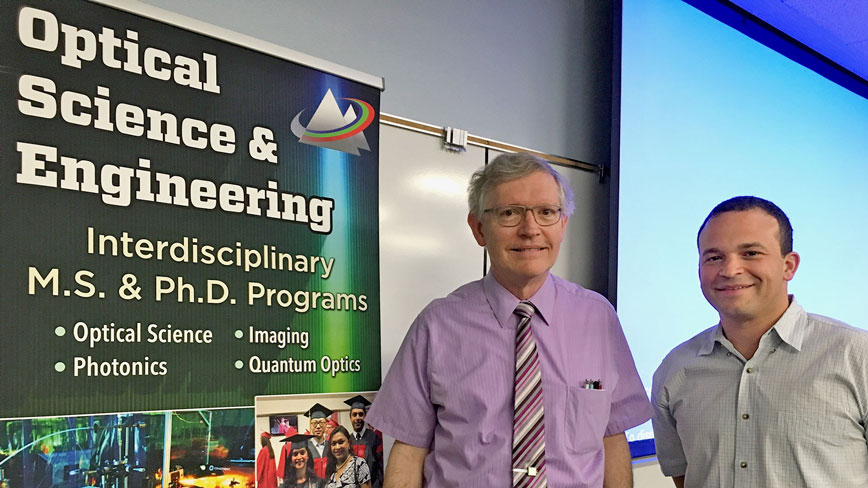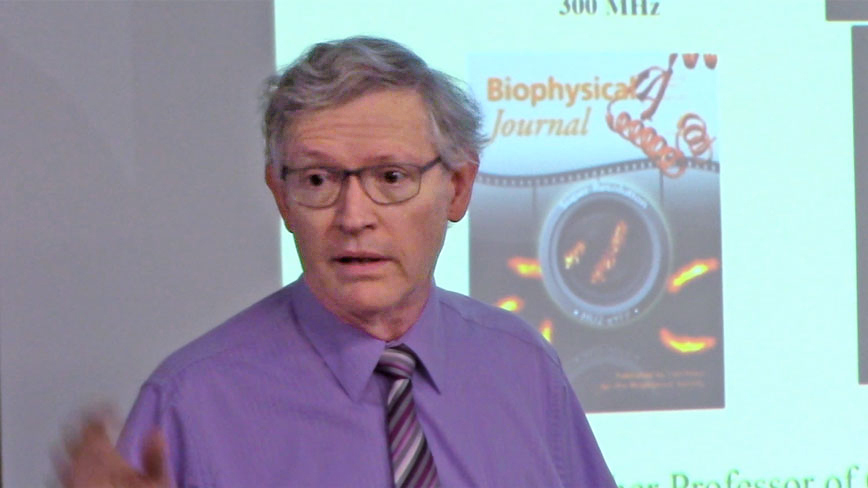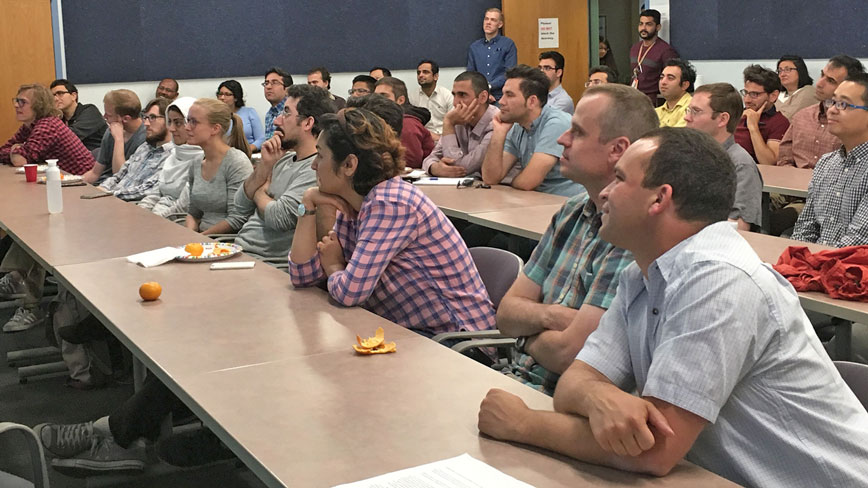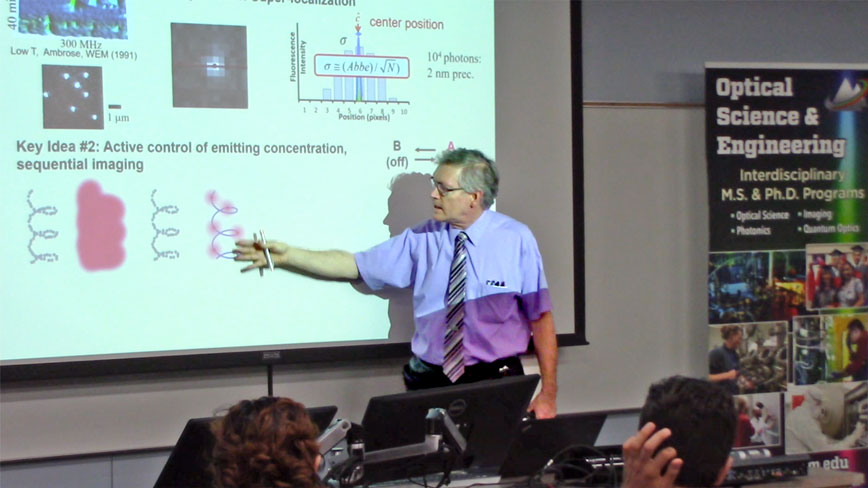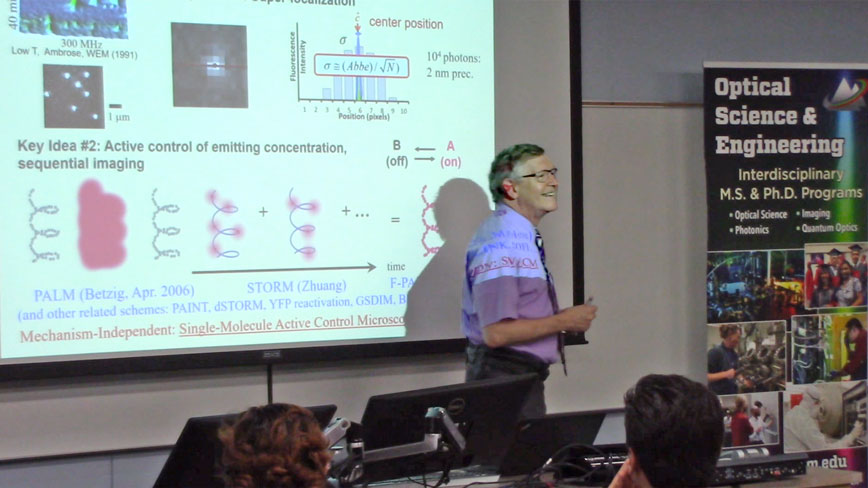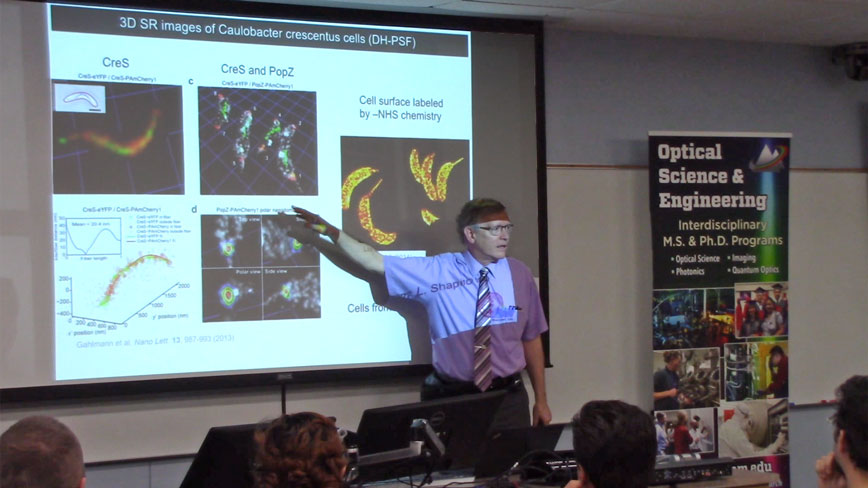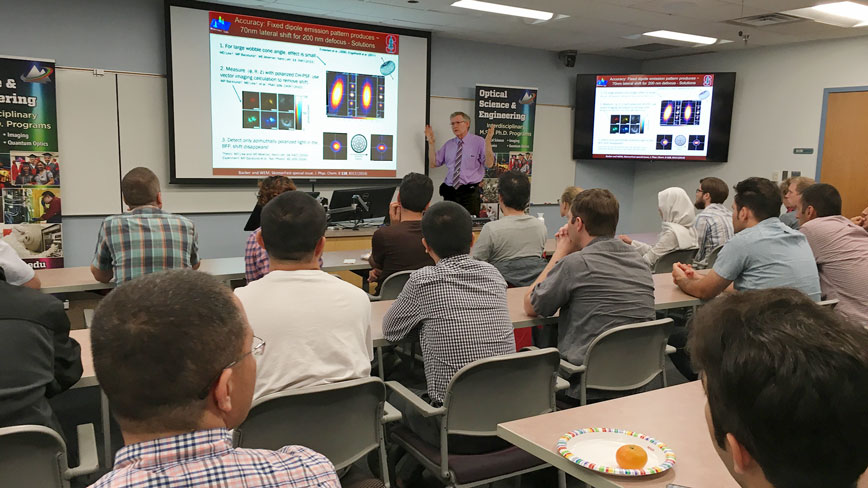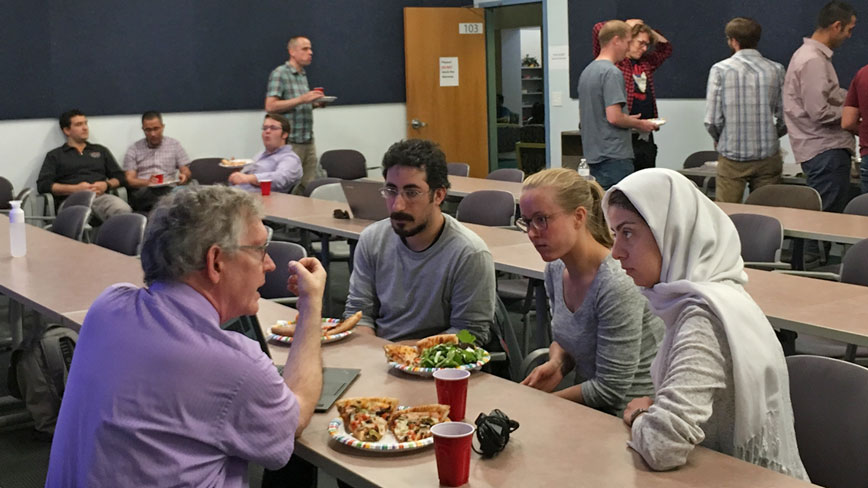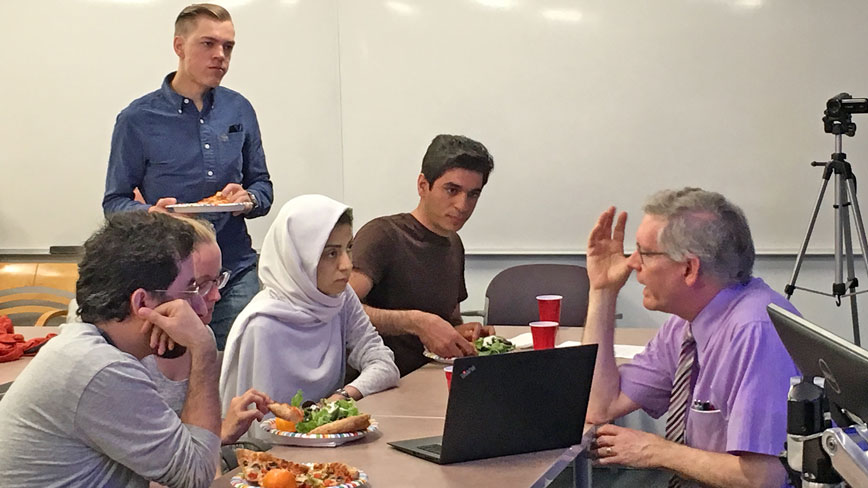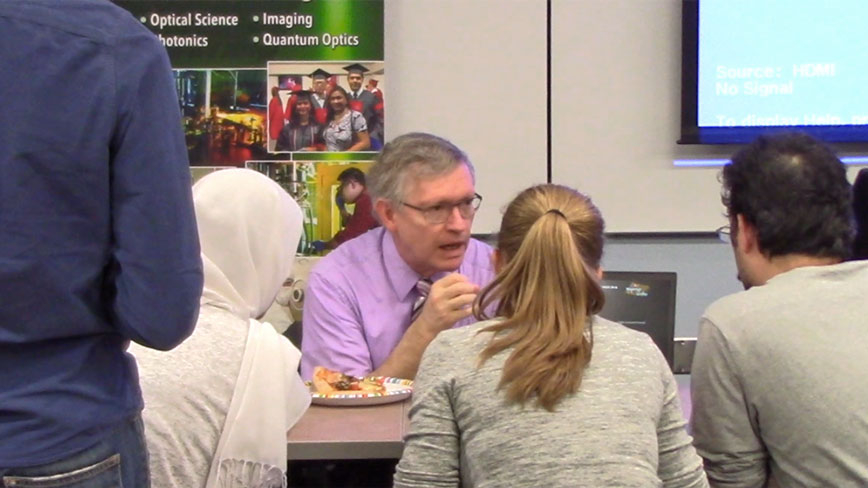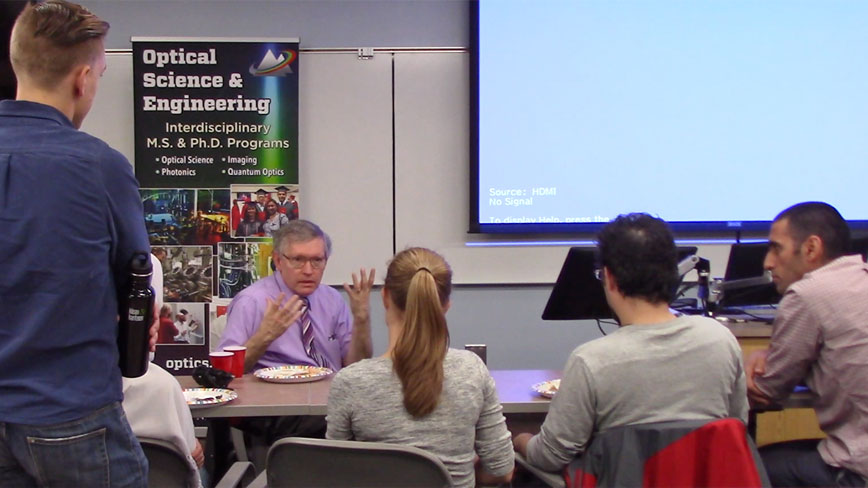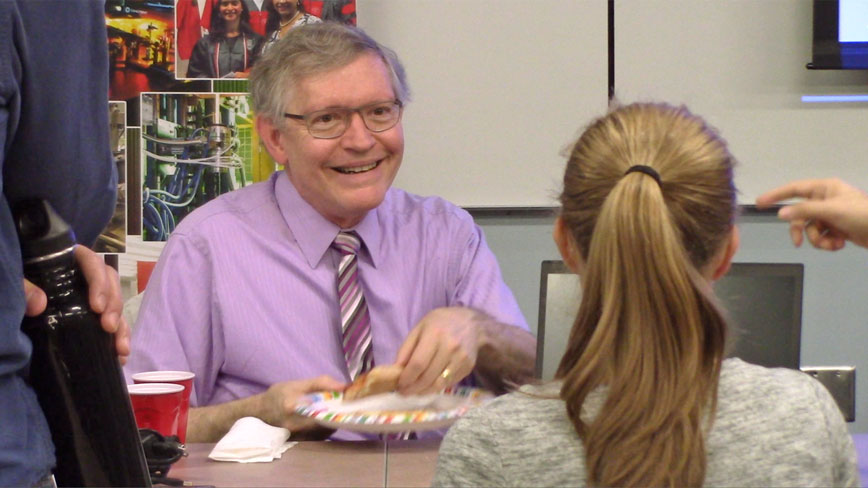2014 Nobel Laureate in Chemistry presents final Seminar for Spring 2017 OSE Series
Departmental News
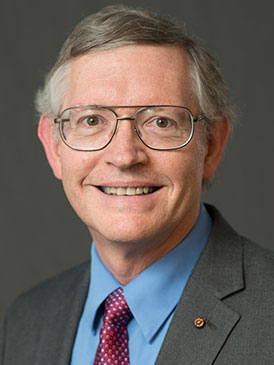
Posted: May 15, 2017
W. E. Moerner is credited with achieving the first optical detection and spectroscopy of a single molecule in condensed phases, along with his postdoc, Lothar Kador. Optical study of single molecules has subsequently become a widely used experiment in chemistry, physics and biology.1
Moerner, the Harry S. Mosher Professor of Chemistry and Professor of Applied Physics at Stanford University, was awarded the 2014 Nobel Prize in Chemistry for his work in developing super-resolution fluorescent microscopy techniques. Moerner’s work is credited with giving scientists the ability to visualize single molecules and to visualize precise molecular mechanisms inside living cells, which opens new windows into how life can be studied. This ability is central to modern research and medicine, and Moerner was recognized for his role in developing the microscopy techniques that make it possible.
"Prior to W.E.'s work, we all believed in molecules, but no one had ever seen one," said his long-time colleague in the Stanford Chemistry Department, Professor Richard N. Zare. "He was the first one to allow us to actually visualize a molecule. It opened up all sorts of new experiments in which you can see how cells divide, how the ribosomes can make proteins, and how the cells work." 3
"We have discovered that bacterial cells are highly, exquisitely organized, and that was not known before," said Lucy Shapiro, a professor of developmental biology at Stanford University School of Medicine and a 10-year collaborator of Moerner's. "We can observe how live cells divide, molecule by molecule. This has been incredible and has opened up whole new worlds to visualize." 3
It has now been more than 28 years since the first optical detection and spectroscopy of a single molecule in an industrial research lab. The progress beyond the early low-temperature, high resolution spectroscopy to the present has been astounding. It is now possible to circumvent the fundamental diffraction limit of light to achieve "super-resolution imaging." 2
Upon receiving the news of the Nobel Prize, Moerner noted: "This is possible because of the incredible work by my group of students and postdocs over a long period of time." 3
Concluding the Spring 2017 OSE Seminar Series on a high note
Moerner was scheduled by the UNM Department of Physics & Astronomy to appear at the Physics and Astronomy Colloquium. Moerner's presentation for the Colloquium was hosted by Victor Acosta, P&A Assistant Professor, who made sure to include a presentation for the OSE Seminar Series during Moerner's trip to UNM.
Students and postdocs from every department at UNM were invited to the final OSE Seminar of the Spring 2017 OSE Seminar Series to hear Moerner present technical insights about experiments and setups for the latest research in the Moerner Lab. He explained some of the observations his team has been able to achieve with their experiments. Students were invited to participate in a question and answer session with the professor. Then, Moerner graciously shared a pizza lunch with the students and postdocs to give the opportunity for more time for discussion.
Professor Keith A. Lidke's students from the Lidke Laboratory and Professor Victor Acosta's students from the Quantum Nanophotonics and Biosensing research group at UNM showed avid interest in Moerner's presentation from the front row of the packed classroom, and Lidke's students made the most of Moerner's time over lunch with one-on-one questions and answers. Research at the Lidke Laboratory involves developing and using optical techniques, specifically fluorescence microscopy, for the study of the distribution, dynamics and interactions of cellular components, so there is some commonality with Moerner's research.
"With light, you can't observe details smaller than less than half a micron," says Moerner. "You can go to factors of 10 or more below that level using fluorescence." 3
Before Moerner's discovery, optical images were fuzzy on spatial scales less than 200 nanometers (nm). Now, super-resolution techniques open up a new realm in which biological structures and behavior can be observed in fixed and live cells with resolutions down to 20-40 nm and below. 2
Assistant Professor of Physics & Astronomy Victor Acosta introduced W. E. Moerner, who presented a fascinating hour of real-world experimental results from the Moerner Lab. Moerner made the most of his time with the students, to optimize their opportunities for questions and discussion.
About W. E. Moerner
W. E. (William Esco) Moerner, the Harry S. Mosher Professor of Chemistry and Professor, by courtesy, of Applied Physics at Stanford University, conducts research in physical chemistry and chemical physics of single molecules, single-molecule biophysics, super-resolution imaging and tracking in cells, and trapping of single molecules in solution. His interests span methods of precise quantification of single molecule properties, to strategies for three-dimensional imaging and tracking of single molecules, to applications of single-molecule measurements to understand biological processes in cells, to observations of the photodynamics of single photosynthetic proteins and enzymes. He has been elected Fellow/Member of the NAS, American Academy of Arts and Sciences, AAAS, ACS, APS, and OSA. Major awards include the Earle K. Plyler Prize for Molecular Spectroscopy, the Irving Langmuir Prize in Chemical Physics, the Pittsburgh Spectroscopy Award, the Peter Debye Award in Physical Chemistry, the Wolf Prize in Chemistry, and the 2014 Nobel Prize in Chemistry. 4
Sources:
- William E. Moerner, Wikipedia
- 2014 Nobel Laureate to speak at UNM, UNM Newsroom, May 08, 2017
- Nobel Prize for Stanford chemist W.E. Moerner, who brings very small things into focus, Stanford Report, October 08, 2014
- CV, short version
